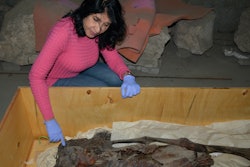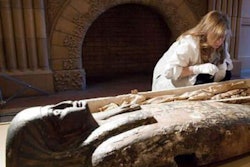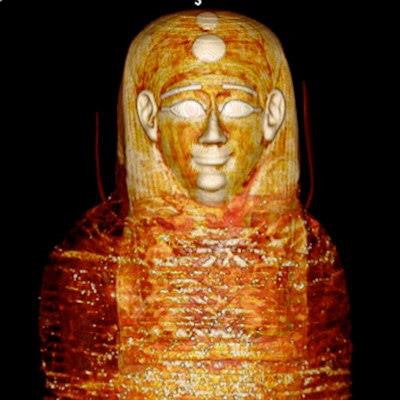
Scientists have "digitally unwrapped" a 2,300-year-old mummy known as golden boy. He was bedecked with 49 amulets intended to protect him as he journeyed into the afterlife, according to a report published on January 24 in Frontiers in Medicine.
The teenage boy was dressed in sandals and festooned with ferns. The amulets were of 21 different types, and while many were made of gold, others were made of semiprecious stones, fired clay, or faience, reported a team led by Dr. Sahar Saleem, professor of radiology at Cairo University. The jewelry included a golden heart scarab placed inside the boy's thoracic cavity and a golden tongue placed in his mouth.
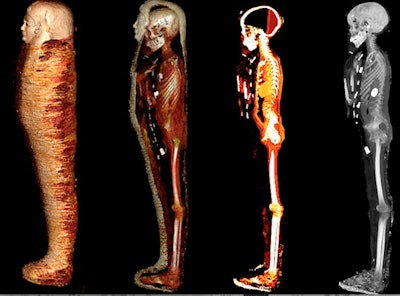 Digital unwrapping visualizations using CT. A series of 3D CT images of the mummy in the left lateral position show the steps of the virtual peeling of the bandages from left to right: the outer surface of the wrapped mummy (far left); partial unwrapping reveals the mummy within the bandages; the totally unwrapped mummy is viewed with a CT window level that highlights the soft tissues and embalming materials; the totally unwrapped mummy is viewed with a CT window level that shows the skeleton and dense amulets related to the mummy (far right). All images courtesy of Dr. Sahar Saleem.
Digital unwrapping visualizations using CT. A series of 3D CT images of the mummy in the left lateral position show the steps of the virtual peeling of the bandages from left to right: the outer surface of the wrapped mummy (far left); partial unwrapping reveals the mummy within the bandages; the totally unwrapped mummy is viewed with a CT window level that highlights the soft tissues and embalming materials; the totally unwrapped mummy is viewed with a CT window level that shows the skeleton and dense amulets related to the mummy (far right). All images courtesy of Dr. Sahar Saleem."This mummy is a showcase of Egyptian beliefs about death and the afterlife during the Ptolemaic period," a statement released by the journal explained. "The ancient Egyptians believed that when we died, our spiritual body sought out an afterlife similar to this world.
"Entry into this afterlife wasn't guaranteed: it first required a perilous journey through the underworld, followed by an individual last judgment. For this reason, relatives and embalmers did everything they could to ensure that their loved one might reach a happy destination," the statement noted.
Saleem and colleagues used CT to image the mummy, finding the fern garlands and the amulets and gaining "unique insight into mummification procedures and beliefs about the importance of grave ornaments" during this ancient period.
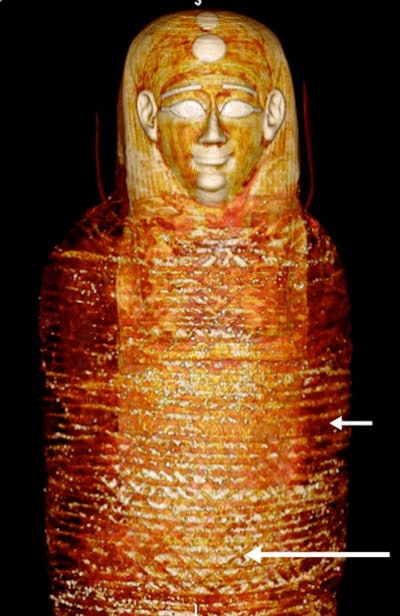 3D CT image of the front of the head and torso of mummy shows the head mask and the most outer bandages arranged transversely (short arrow) and diagonally in a criss-cross orientation (long arrow).
3D CT image of the front of the head and torso of mummy shows the head mask and the most outer bandages arranged transversely (short arrow) and diagonally in a criss-cross orientation (long arrow)."[The amulets were] beautifully stylized in a unique arrangement of three columns between the folds of the wrappings and inside the mummy's body cavity," Saleem said in the journal statement. "These include the Eye of Horus, the scarab, the akhet amulet of the horizon, the placenta, the Knot of Isis, and others."
Although the mummy was discovered in 1916, it had been in storage in the basement of Cairo's Egyptian Museum until Saleem's group conducted their research. It was laid in an outer coffin with Greek inscriptions and an inner wooden sarcophagus; the boy wore a gilded head mask, a chest shield, and sandals. His viscera and brain had been removed. He was about 14 or 15 years old, 4 feet tall, and uncircumcised, and his death appeared to be of natural causes, the researchers reported.
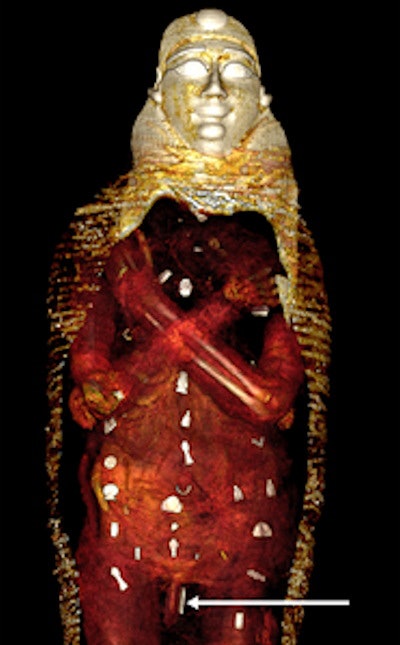 3D CT image of the front of the digitally unwrapped torso of mummy shows the crossed arms position and the amulets. The separately wrapped upper limbs are bent at the elbows and crossed in front of the chest. Amulets are seen arranged in three columns on the front surface of the torso. An amulet is placed beside the penis.
3D CT image of the front of the digitally unwrapped torso of mummy shows the crossed arms position and the amulets. The separately wrapped upper limbs are bent at the elbows and crossed in front of the chest. Amulets are seen arranged in three columns on the front surface of the torso. An amulet is placed beside the penis."According to the ancient Egyptians' ritual Book of The Dead, the deceased had to wear white sandals to be pious and clean before reciting its verses," Saleem said. As for the presence of the fern garland, "ancient Egyptians were fascinated by plants and flowers and believed they possessed sacred and symbolic effects," she noted. "Bouquets of plants and flowers were [often] placed beside the deceased at the time of burial."
The researchers also discovered the following:
- A golden tongue leaf set inside the mouth so that the boy could speak in the afterlife
- A two-finger amulet placed beside his penis to protect the embalming incision
- An Isis knot to protect the body
- A golden scarab beetle positioned inside the boy's thoracic cavity (the team made a 3D-printed copy of this amulet)
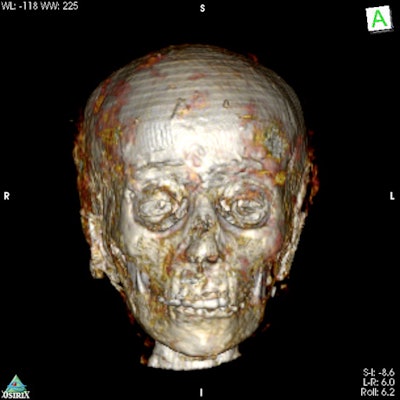 3D CT image shows oval face, with a small nose, a narrow chin, and partially open eyes.
3D CT image shows oval face, with a small nose, a narrow chin, and partially open eyes.The boy also had a heart scarab placed in his torso, which was "important in the afterlife during judging the deceased and weighing of the heart against the feather of the goddess Maat," Saleem pointed out.
The mummy is now installed in the Egyptian Museum's main exhibition hall, where visitors can admire it in its entirety and view CT images and the 3D-printed version of the heart amulet.






